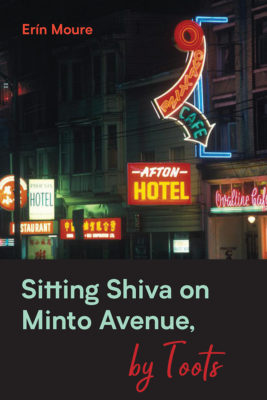When an intrepid explorer of language and thought sits down to shine light on the nature of memory and grief, you suspect you’re in for an extraordinary voyage. In this intricately layered book, a cross-genre narrative encompassing memoir, biography, goodbye letter, and poetic socio-historic treatise stretching from Vancouver to Montreal, Erín Moure reminds us that memory transcends mortality, that in our rawest grief, love and reflection can offer the greatest shelters. The disclaimer upfront avows that “memory is a work of the imagination.” Moure, author of two dozen books, including many poetry collections, delivers an artful feat of the imaginary anchored in truth and authenticity.
Beginning with the title, Moure introduces elements of mystery and intrigue. Most of us know that sitting shiva refers to the Jewish tradition of mourning over a seven-day period during which the bereaved does not leave the house. But where is Minto Avenue and who on earth (or in heaven) is Toots? All we know at the outset is the one clue given on the book’s back cover: “No one alive now knows who Toots is.” Among the pleasures of reading the book is the process of discovery and revelation related to the characters and their settings.
Early on, the narrator draws us into the story as we learn she’s just received the phone call that nobody ever wants to receive. The caller informs her of the death of a friend she once loved and who loved her back. Paul Émile Savard, born in 1943, died in December 2015, alone in a Vancouver hospital. From the moment she receives the call, the narrator embraces the act of remembrance, excavating memory and exposing her grief.

Sitting Shiva on Minto Avenue, by Toots
Erín Moure
New Star Books
$21.00
paper
160pp
9781554201419
In this book, the very act of remembering, moving back and forth through time and geography, lends an immediacy and believability to the narrative. The reader feels present, sitting shiva at the narrator’s side in Montreal as she reveals the characters and emotional texture of their story while exploring all manner of ideas and relevant facts, meticulously researched and sourced, on historical events and philosophical questions, on sites like Belmont Park, and on restaurants and buildings in Vancouver and Montreal, to confirm and authenticate her memories of scenes such as this one:
In the Gasthouse on Robson Street west of Burrard, we’d eat big schnitzels and drink Blue Nun wine. One night we left the restaurant and he was very drunk and stopped in the street and looked up at a streetlight and thought it was the sun and said what he used to say to the sun: Shine on me, little star.
I still do that to streetlights in his honour. Shine on me, little star.
The specificity of such moments reflects the nature of memory, how thinking back to the times spent with the little man during the seventies conjures details that yield further details to create a portrait that clarifies before our eyes, enriched by recurring images and metaphors written with the precision and instincts of a poet. mRb
Author photo by Karis Shearer






So many touchstones here. Thanks for the wonderful review of what is sure to be a moving read.
Very good review, Cora, and what sounds like a fascinating book. Thank you.